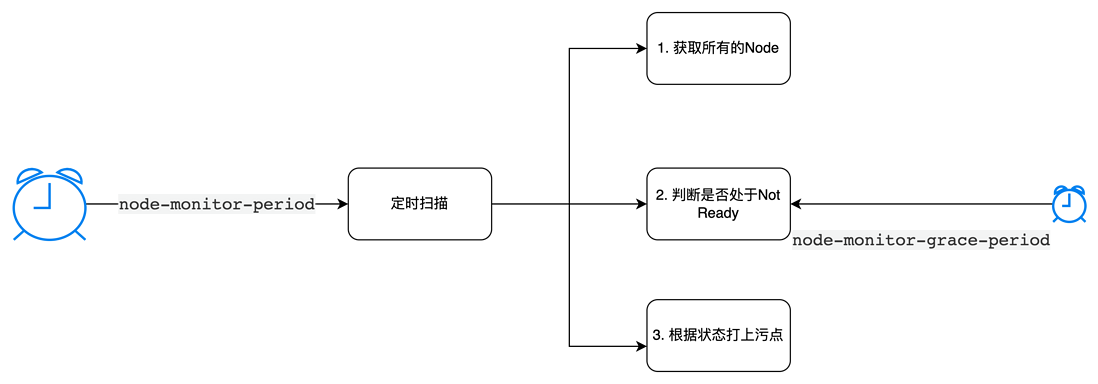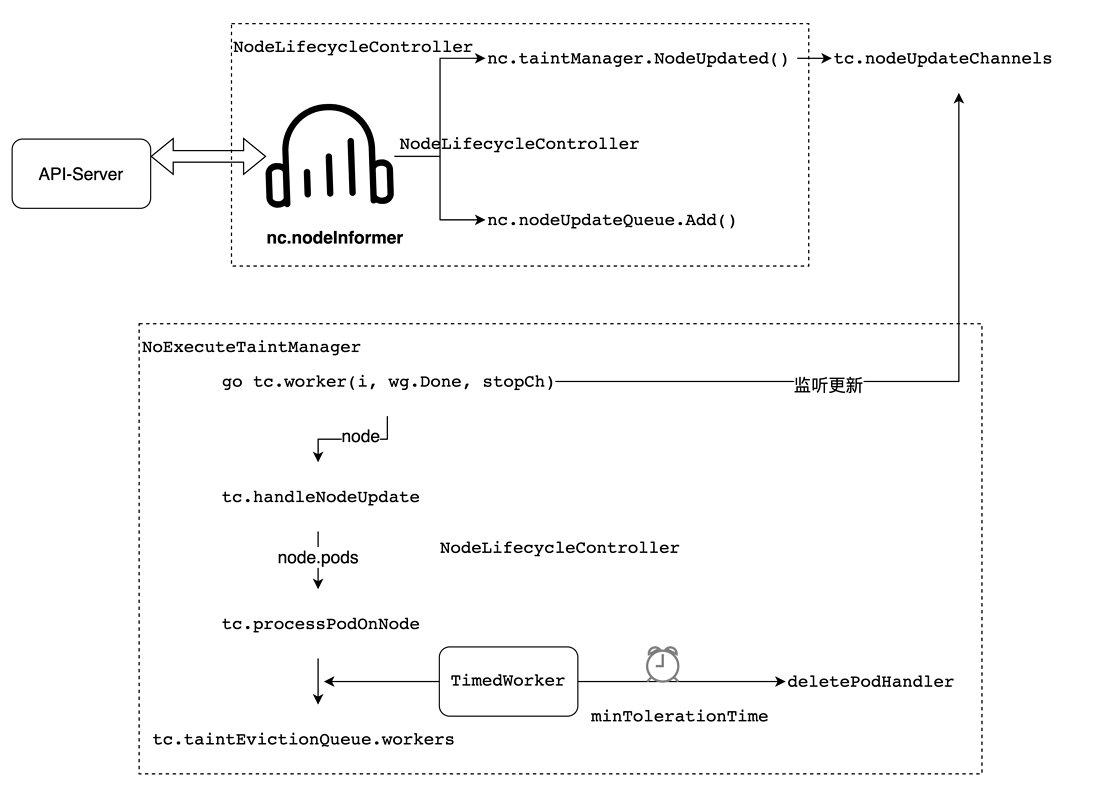K8s对于kubelet宕机迁移的处理在不同的版本有不同的演进,所以网上很多文章关于如何加快这个时间的说法并不一致,甚至有些检索出来没什么用处。
早期搜索到一些文章,指定了一个关键参数 pod-eviction-timeout ,驱逐pod的等待时间,可是发现修改该参数无效,通过阅读源码,发现并没有使用到这个参数,怀疑是一个废弃的参数,通过翻阅很多资料后,发现不同的版本,是有不同的驱逐逻辑的。
<小于1.13版本: 没有启用污点管理器特性时,Pod的迁移由以下四个参数决定,
node-status-update-frequency, 节点上报频率,默认为10snode-monitor-period, node控制器每隔多长时间监控一次node状态,默认为5snode-monitor-grace-period, node控制器间隔多长时间后会将Node设置为Not Ready, 默认为40spod-eviction-timeout, node控制器间隔多长时间后开始驱逐Pod
- 版本大于等于1.14小于1.18: 默认启用污点管理器特性,通过污点管理器的机制驱逐Pod
- 版本大于1.18:必须启动污点管理器,其实旧的代码已经没有意义了
污点机制介绍
节点亲和性 是 Pod 的一种属性,它使 Pod 被吸引到一类特定的节点 (这可能出于一种偏好,也可能是硬性要求)。
污点(Taint) 则相反——它使节点能够排斥一类特定的 Pod。
容忍度(Toleration) 是应用于 Pod 上的。容忍度允许调度器调度带有对应污点的节点。 容忍度允许调度但并不保证调度:作为其功能的一部分, 调度器也会评估其他参数。
污点和容忍度(Toleration)相互配合,可以用来避免 Pod 被分配到不合适的节点上。 每个节点上都可以应用一个或多个污点,这表示对于那些不能容忍这些污点的 Pod, 是不会被该节点接受的。
简单来说,按照污点和容忍的机制考虑,一切对于Pod的驱逐,都可以适用这套机制,包括由于kubelet故障导致的。
源码分析
1. 将node设置为Not Ready
Node控制器会周期性检查node的状态,如果发现有心跳时间超过了 node-monitor-grace-period的,就认为是不可达了,将给该节点赋予Taint.
# node_lifecycle_controller.go
monitorNodeHealth()
// 1. 获取所有的node
--> nodes, err := nc.nodeLister.List(labels.Everything())
// 2. 根据心跳时间判断是否出现了Not Ready
--> gracePeriod, observedReadyCondition, currentReadyCondition, err = nc.tryUpdateNodeHealth(node)
// 3. 为node设置taint
--> nc.processTaintBaseEviction(node, &observedReadyCondition)2. 监听Node更新事件,触发驱逐
一旦Node被赋予了Taint,那么已经注册在 NodeLifecycleController 中的 nodeInformer 就会监听到该事件,并将该node对象传入tc.nodeUpdateChannels ;
tc 是 NoExecuteTaintManager 污点管理对象,它会监听 tc.nodeUpdateChannels ,将node传给方法 tc.handleNodeUpdate ,然后查询node中的所有Pod,调用 tc.processPodOnNode 方法进行处理;
processPodOnNode 会创建一个TimedWorker 对象,这是一个具备定时执行能力的对象,当时间到了就会调用指定的方法: deletePodHandler, 对Pod进行驱逐。
那么 TimedWorker 的定时时间是多少呢,污点管理器会求一个 minTolerationTime, 也就是最小容忍时间。这个容忍时间会找到 pod.Spec.Tolerations 中的容忍时间。
那么Pod中的这个容忍时间是什么时候写入的呢?
3. 默认容忍时间
我们执行 kubectl describe pod xxx, 会发现Pod中已经写入了一个针对污点 node.kubernetes.io/not-ready:NoExecute 和 node.kubernetes.io/unreachable 的容忍,并且指定了容忍时间为 300s。
Tolerations: node-role.kubernetes.io/master:NoSchedule
node.kubernetes.io/not-ready:NoExecute op=Exists for 300s
node.kubernetes.io/unreachable:NoExecute op=Exists for 300s通过查阅资料,发现Pod中的默认驱逐污点是API-Server设置的。
Kubernetes 会自动给 Pod 添加针对
node.kubernetes.io/not-ready和node.kubernetes.io/unreachable的容忍度,且配置tolerationSeconds=300, 除非用户自身或者某控制器显式设置此容忍度。这些自动添加的容忍度意味着 Pod 可以在检测到对应的问题之一时,在 5 分钟内保持绑定在该节点上。
--default-not-ready-toleration-seconds int Default: 300
Indicates the tolerationSeconds of the toleration for notReady:NoExecute that is added by default to every pod that does not already have such a toleration.
--default-unreachable-toleration-seconds int Default: 300
Indicates the tolerationSeconds of the toleration for unreachable:NoExecute that is added by default to every pod that does not already have such a toleration.
4. API-Server配置默认容忍
plugin/pkg/admission/defaulttolerationseconds/admission.go:43
var (
defaultNotReadyTolerationSeconds = flag.Int64("default-not-ready-toleration-seconds", 300,
"Indicates the tolerationSeconds of the toleration for notReady:NoExecute"+
" that is added by default to every pod that does not already have such a toleration.")
defaultUnreachableTolerationSeconds = flag.Int64("default-unreachable-toleration-seconds", 300,
"Indicates the tolerationSeconds of the toleration for unreachable:NoExecute"+
" that is added by default to every pod that does not already have such a toleration.")
notReadyToleration = api.Toleration{
Key: v1.TaintNodeNotReady,
Operator: api.TolerationOpExists,
Effect: api.TaintEffectNoExecute,
TolerationSeconds: defaultNotReadyTolerationSeconds,
}
unreachableToleration = api.Toleration{
Key: v1.TaintNodeUnreachable,
Operator: api.TolerationOpExists,
Effect: api.TaintEffectNoExecute,
TolerationSeconds: defaultUnreachableTolerationSeconds,
}
)
// Admit makes an admission decision based on the request attributes
func (p *Plugin) Admit(ctx context.Context, attributes admission.Attributes, o admission.ObjectInterfaces) (err error) {
......
if !toleratesNodeNotReady {
pod.Spec.Tolerations = append(pod.Spec.Tolerations, notReadyToleration)
}
if !toleratesNodeUnreachable {
pod.Spec.Tolerations = append(pod.Spec.Tolerations, unreachableToleration)
}
......
}应该是api-server准入判断中增加的逻辑,默认给pod增加了容忍污点。
总结
通过查阅资料和源码,总算搞清楚了Pod的宕机驱逐逻辑实现,可谓是天马行空、羚羊挂角,从kubelet的心跳到controler-manager中的node控制器的监听,再到api-server对pod的默认污点,还包含scheduler不再调度到该node的设定,基本涵盖了所有的控制组件了。
并且其中大量使用channel,队列,解耦做的非常彻底,但是源码的阅读也增加了不少困难。社区随着版本迭代也在不断的对代码进行优化,重构,摸清k8s的实现机制,是一个有趣且富有挑战的工作。



**粗体** _斜体_ [链接](http://example.com) `代码` - 列表 > 引用。你还可以使用@来通知其他用户。